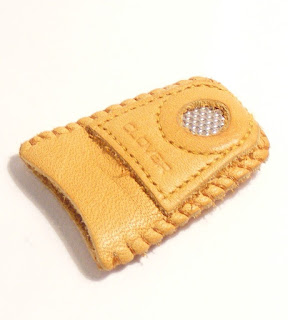There is a downside to hand-quilting, and that's the toll it's taken on my once soft and shapely fingertips. I used to take great pride in my hands but now they have a decidedly workman-like look to them. My fingers have become dry and dimpled from pushing needles through stubborn layers of fabric, and resemble a golfball's surface. My left hand (I am right-handed) gets its fair share of abuse too, as the bloodstains from numerous pinpricks on the back of my quilts prove.
Tip: If you do spill blood on your work, your own saliva contains a chemical that will get rid of the offending stain–only your own saliva will do though!
So, I recently decided to start using a thimble, but which type when there are so many to choose from? I have several metal thimbles, no longer used as they compromise dexterity and make my fingers sweat. Now they lurk somewhere in the corner of a sewing box, hoping for a meaningful return to life, which I can only foresee happening, if, in the unlikely event, I decide to join a skiffle band. Of course, this would please my father greatly since he’s fanatical about English folk music and always wanted me to follow in his musical footsteps. I (on the other thimbleless hand) would have been equally delighted if he had been an expert tailor and taught me how to use a thimble! But I digress…
Rubber thimbles also make fingers sweaty and uncomfortable, while pottery thimbles, being in my opinion, purely decorative, can instantly be dismissed. Open-ended, tailor's thimbles, although apparently allowing for better dexterity, seem to defeat their purpose as they simply expose the bit of my finger I want to protect.
So, I recently decided to start using a thimble, but which type when there are so many to choose from? I have several metal thimbles, no longer used as they compromise dexterity and make my fingers sweat. Now they lurk somewhere in the corner of a sewing box, hoping for a meaningful return to life, which I can only foresee happening, if, in the unlikely event, I decide to join a skiffle band. Of course, this would please my father greatly since he’s fanatical about English folk music and always wanted me to follow in his musical footsteps. I (on the other thimbleless hand) would have been equally delighted if he had been an expert tailor and taught me how to use a thimble! But I digress…
Rubber thimbles also make fingers sweaty and uncomfortable, while pottery thimbles, being in my opinion, purely decorative, can instantly be dismissed. Open-ended, tailor's thimbles, although apparently allowing for better dexterity, seem to defeat their purpose as they simply expose the bit of my finger I want to protect.
Unsuited to my needs, but nevertheless intriguing are Shashiko thimbles which are used for a style of Japanese embroidery that mimics grains of rice on a blue background. A thimbling aberration and worn at the base of the middle finger shashiko thimbles protect the fleshy part of your palm as you push a particularly long needle through fabric. If you want to find out more about it, the purl bee provides an excellent tutorial on Shashiko techniques.
After much trial and error, I've found that a leather coin thimble (see below) is best for me. Okay, so it bears an unpleasant resemblance to a prosthetic, but it does the job: the natural material lets my finger breathe (so no sweat) and the coin is useful for pushing needles through tough layers of fabric. I only wish I'd bought a smaller size as mine has stretched quite a bit, next time I'll know better.
If you also think your fingers could do with a little armour, but are unsure how to get the most out of a thimble, I highly recommend you take a peek at this post by the house of marmalade.
If you also think your fingers could do with a little armour, but are unsure how to get the most out of a thimble, I highly recommend you take a peek at this post by the house of marmalade.
Did you know: Early thimbles were made from bone or ivory? Thimble-knocking also refers to the practice of Victorian schoolmistresses who would tap on the heads of unruly pupils with dames thimbles–ouch!



No comments:
Post a Comment
Comment away, I'd love to hear from you!